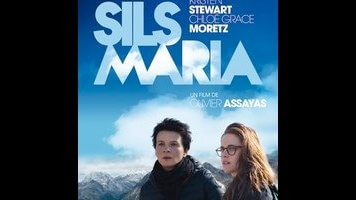Juliette Binoche and Kristen Stewart shine in Olivier Assayas’ Clouds Of Sils Maria

Maria Enders, acclaimed and glamorous actress, is crossing into Switzerland by train, accompanied by her girl Friday personal assistant, Valentine. She is in the middle of a divorce and a Chanel campaign, and the trip is to see an old friend who lives near Sils-Maria, in the Grison Alps. What Maria and Valentine don’t know is that said friend—writer of Maloja Snake, the play that launched Maria’s career—has committed suicide. At the tribute evening that becomes an impromptu memorial service, Maria will be approached by an up-and-coming director. He’s staging Maloja Snake in London, with Jo-Ann Ellis, tabloid-fixture star of a young-adult-type sci-fi franchise, in the role Maria made famous: Sigrid, the young woman who seduces and destroys her boss, Helen. Would Maria consider playing Helen?
If ever a movie came with instructions for how it’s expected to be read, then this is it. Clouds Of Sils Maria is writer-director Olivier Assayas’ take on the Ingmar Bergman psychological drama, complete with a secluded setting in the form of the writer’s house, where Maria holes up with Valentine while re-learning and rehearsing Maloja Snake. It’s also a movie about actors acting, in which characters are continually refracted through the roles they play.
After all, doesn’t the relationship between Maria and Valentine, who reads for Sigrid in rehearsal, sometimes creepily mirror the one between the women in the play? Isn’t it sometimes difficult to tell when they’re talking and when they’re rehearsing? Doesn’t Jo-Ann Ellis sort of recall Kristen Stewart, who plays Valentine? Isn’t Maloja Snake basically a reworking of The Bitter Tears Of Petra Von Kant by Rainer Werner Fassbinder, whose Beware Of A Holy Whore was a major reference point for Irma Vep, another Assayas film about an actress who gets lost in her role? And didn’t Juliette Binoche, who plays Maria, get her breakthrough with Rendez-Vous, written by Assayas? Doesn’t the movie’s focus on death, inheritance, and changing seasons connect it with Assayas’ earlier Late August, Early September and Summer Hours?
With so much suggested by text and italicized subtext, it doesn’t seem like there is a whole lot left for viewers to experience on their own. But Assayas—cosmopolitan stylist of movies where everyone speaks English as a second language—is too energetic and graceful a director to let Clouds Of Sils Maria turn into an exercise in pure explicated theme. There are broad strokes (see: Jo-Ann Ellis’ movies, drawn so crudely, they seem to belong in a Frank Tashlin satire), but also plenty of small and subtle ones, some so organic that it’s hard to tell what might be scripted and what might be the result of Assayas creating a comfortable space for the cast. Binoche and Stewart inhabit their characters’ complicated friendship, whether they’re doing the nuts-and-bolts, behind-the-scenes business of managing a career or getting drunk at a small casino. (Not to put too fine a point on it, but Stewart—who already won a Best Supporting Actress Cesar for the film—is a gifted actor who had the bad luck to get famous for lousy roles.) Even Jo-Ann (Chloë Grace Moretz), the ambitious gossip item with the permanent hickey on her neck, is more complicated than just a refraction of the Sigrid character.
Gradually, something like a buried theme emerges from the movie’s continual contrasting of dim interior space—the writer’s house, navigated in restless handheld widescreen—and the vast static vistas of the Alps. It’s that push and pull between the interior and exterior, the emotional toll of performing a role, with the definition of “role” expanded to include being yourself.